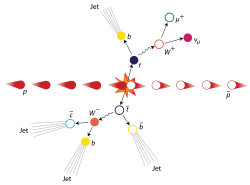
Back Bokwark Afrikaans كوارك قمي Arabic Quark visu AST T-кварк Byelorussian Топ кварк Bulgarian Quark t Catalan Kvark t Czech Top-kvark Danish Top-Quark German Τοπ κουάρκ Greek
 A collision event involving top quarks | |
| Composition | elementary particle |
|---|---|
| Statistics | fermionic |
| Family | quark |
| Generation | third |
| Interactions | strong, weak, electromagnetic, gravity |
| Symbol | t |
| Antiparticle | top antiquark ( t ) |
| Theorized | Makoto Kobayashi and Toshihide Maskawa (1973) |
| Discovered | CDF and DØ collaborations (1995) |
| Mass | 172.76±0.3 GeV/c2[1] |
| Mean lifetime | 5×10−25 s |
| Decays into | bottom quark (99.8%) strange quark (0.17%) down quark (0.007%) |
| Electric charge | + 2 /3 e |
| Color charge | yes |
| Spin | 1 /2 ħ |
| Topness | 1 |
| Weak isospin | LH: + 1 /2, RH: 0 |
| Weak hypercharge | LH: +1 /3, RH: +4/3 |
The top quark, sometimes also referred to as the truth quark, (symbol: t) is the most massive of all observed elementary particles. It derives its mass from its coupling to the Higgs field. This coupling yt is very close to unity; in the Standard Model of particle physics, it is the largest (strongest) coupling at the scale of the weak interactions and above. The top quark was discovered in 1995 by the CDF[2] and DØ[3] experiments at Fermilab.
Like all other quarks, the top quark is a fermion with spin-1/2 and participates in all four fundamental interactions: gravitation, electromagnetism, weak interactions, and strong interactions. It has an electric charge of + 2 /3 e. It has a mass of 172.76±0.3 GeV/c2,[1] which is close to the rhenium atom mass.[4] The antiparticle of the top quark is the top antiquark (symbol: t, sometimes called antitop quark or simply antitop), which differs from it only in that some of its properties have equal magnitude but opposite sign.
The top quark interacts with gluons of the strong interaction and is typically produced in hadron colliders via this interaction. However, once produced, the top (or antitop) can decay only through the weak force. It decays to a W boson and either a bottom quark (most frequently), a strange quark, or, on the rarest of occasions, a down quark.[a]
The Standard Model determines the top quark's mean lifetime to be roughly 5×10−25 s.[5] This is about a twentieth of the timescale for strong interactions,[b] and therefore it does not form hadrons, giving physicists a unique opportunity to study a "bare" quark (all other quarks hadronize, meaning that they combine with other quarks to form hadrons and can only be observed as such).
Because the top quark is so massive, its properties allowed indirect determination of the mass of the Higgs boson (see § Mass and coupling to the Higgs boson below). As such, the top quark's properties are extensively studied as a means to discriminate between competing theories of new physics beyond the Standard Model. The top quark is the only quark that has been directly observed due to its decay time being shorter than the hadronization time.[b][6]
- ^ a b Cite error: The named reference
PDG2020was invoked but never defined (see the help page). - ^ Cite error: The named reference
CDF-1995was invoked but never defined (see the help page). - ^ Cite error: The named reference
D0-1995was invoked but never defined (see the help page). - ^ Cite error: The named reference
Hypertextbookwas invoked but never defined (see the help page). - ^ Cite error: The named reference
Quadtwas invoked but never defined (see the help page). - ^ Aubert, Jean-Jacques; Gastmans, Raymond; Gérard, Jean-Marc (6 December 2012). Particle Physics: Ideas and recent developments. Springer, Dordrecht. p. 69. ISBN 978-0-7923-6436-8. Retrieved 11 June 2020.
Cite error: There are <ref group=lower-alpha> tags or {{efn}} templates on this page, but the references will not show without a {{reflist|group=lower-alpha}} template or {{notelist}} template (see the help page).